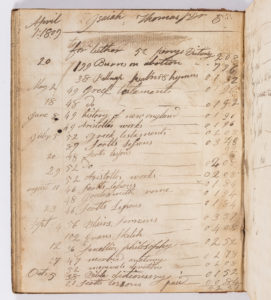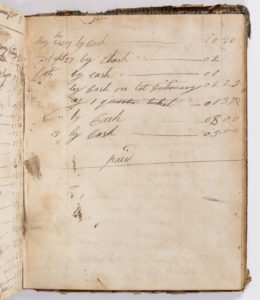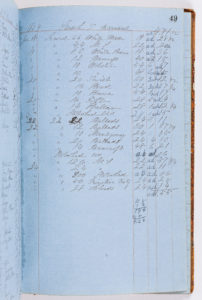This summer, even amidst the COVID-19 pandemic, I was given the immense privilege to be the first Seiler Curatorial Intern at the American Antiquarian Society. Even through uncertain times, the Society and my supervisor Ashley Cataldo, Curator of Manuscripts, advocated for my internship and was able to offer me a blended virtual and in-person experience.
As someone who is at the very beginning of their career, I was not entirely sure what to expect when I first arrived (with mask on) to Antiquarian Hall. I had no idea just how incredible and vast the collection was, especially the book trades manuscript collection, one of the largest collections of book trades history in the United States. As an intern, my goal coming in was to soak up as much experience and information as I could, while also contributing to the overall mission of AAS, with a focus on accessibility. With the help of Ashley, I was able to take on a new project, on which I compiled all the manuscript book trades items into a complete, comprehensible web page.
My journey with working in this collection started with a few key manuscripts that really highlight the assortment of resources that the book trades manuscripts can offer to scholars. These manuscripts (as well as the collection as a whole) can provide bridges in the gaps of the archive by representing underrepresented voices like women and African Americans and give all of us a deeper understanding of our past.
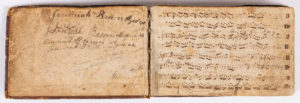 These manuscripts also allow us to see connections within our own local community that we may have never seen before. The Whittemore collection is a perfect illustration of how the book trades intertwine with the Worcester community, including AAS. One of the local discoveries I found in the collections were John and Clark Whittemore, binders working in the Leicester, MA, area with had deep connections with the bookbinding industry in central Massachusetts. I worked to catalog nine account books in total as part of the Whittemore collection. I was surprised to find that not only did Clark Whittemore work with Isaiah Thomas, the founder of American Antiquarian Society, but also his son Isaiah Thomas Jr. At this time, Isaiah Thomas Jr. was helping with his father’s book store and bindery, even though he was kept at a distance because of his poor business skills. For this reason, Thomas’ son never really took over the family business, but these accounts prove that he was not exempt from participating at this time. It’s extremely exciting to see that these account books show the interconnected relationships between book binders in Worcester, Massachusetts, at the time.
These manuscripts also allow us to see connections within our own local community that we may have never seen before. The Whittemore collection is a perfect illustration of how the book trades intertwine with the Worcester community, including AAS. One of the local discoveries I found in the collections were John and Clark Whittemore, binders working in the Leicester, MA, area with had deep connections with the bookbinding industry in central Massachusetts. I worked to catalog nine account books in total as part of the Whittemore collection. I was surprised to find that not only did Clark Whittemore work with Isaiah Thomas, the founder of American Antiquarian Society, but also his son Isaiah Thomas Jr. At this time, Isaiah Thomas Jr. was helping with his father’s book store and bindery, even though he was kept at a distance because of his poor business skills. For this reason, Thomas’ son never really took over the family business, but these accounts prove that he was not exempt from participating at this time. It’s extremely exciting to see that these account books show the interconnected relationships between book binders in Worcester, Massachusetts, at the time.
Before coming to AAS, I didn’t understand how an account book from this time period could give such incredible insight, but these ledgers and waste-books prove to be an important piece of the book trades puzzle. They allow us to see the day to day, sometimes mundane transactions, as well as how much people were paid for their labor, and what titles or authors were most popular at the time. The book trades manuscripts aren’t just for bibliophiles, they give insight into popular culture, trends in labor and can inevitably show a holistic view of American life. Overall, these accounts prove that binders were part of a larger community, one that the American Antiquarian Society has deep roots in.
The importance of the account book again proves itself in one of the first objects I worked with and cataloged: the Ticknor and Fields account book, from the late 1850s in Boston. At first glance, it may look like any other binder’s account book, but, upon further inspection, it reveals itself as a valuable piece into how gender specifically played a role in the book trades collection. The account book actually has the names of twenty-nine different women book binders who worked on Ticknor and Fields titles. Some authors mentioned include the poets Henry Wadsworth Longfellow and Alfred Lord Tennyson. A book entitled White Horse by Thomas Hughes also seems to have been one of the most popular titles of the time as it pops up on almost every page.
Women surprisingly played an absolutely vital role in book binding in the mid-nineteenth century. It was believed that because of their slenderer hands they could fold and sew faster than a man. Not to mention, sewing was already considered women’s work. Not only were they faster, but because they were women, they could be paid significantly less than a man. By the middle part of the century, binderies were employing hundreds of women to do work at a reduced cost. Although they were prevalent in this time it is rare still to find actual accounts of their work with their names attached. This account book gives us insight into how much the women were actually paid for work and can prove that the underpaying of women based solely on gender is embedded in almost every profession in the United States. I was especially happy to be able to bring this manuscript to life and make it an accessible piece for scholars to do more research with.
One of the main through lines in my experience here at AAS has been to shed light on, and make more accessible items written by or about women, African Americans, or indigenous groups. My favorite manuscript item, so far, that I researched and cataloged has been an autographed copy of a sermon by Lemuel Haynes.
Haynes was one of the most significant African Americans of his time. Born in 1753 in Connecticut to an evangelical family and used the Bible to improve his literacy. He then served in the Continental Army during the Revolutionary War, which then inspired his anti-slavery essay “Liberty Further Extended” calling for immediate emancipation; the essay is the earliest known work by an African American that attacks the institution of slavery. Haynes then went on to study theology and is believed to have been the first African American to become an ordained minister in the new United States of America. He then moved to Vermont to be a preacher where many of his sermons would become famous.
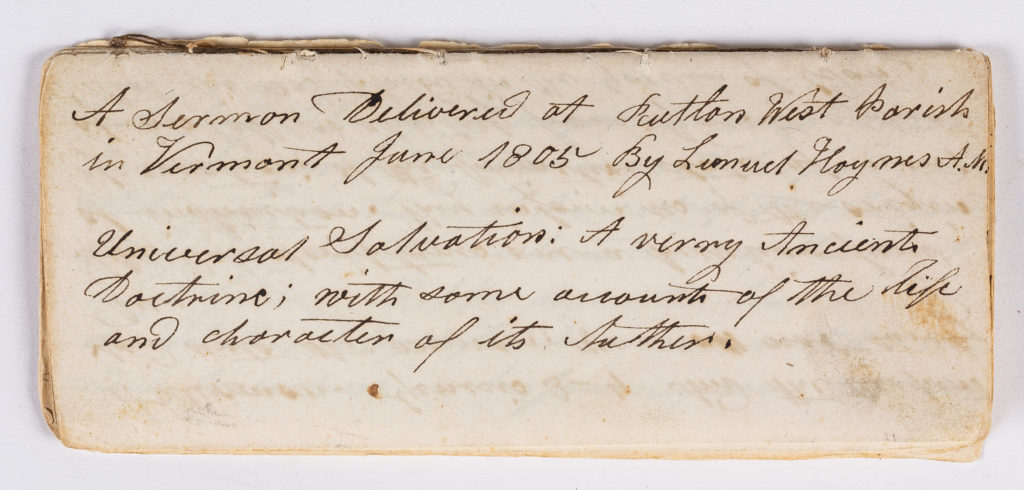 Delivered in 1805, this sermon in particular was a response to the dangers of universal salvation, one of the biggest theological debates among the ministry in this time. Shortly after the sermon was given, Haynes wrote it out in this manuscript copy for it to be published that same year by William Fessenden. This is one of only three manuscript copes of sermons written in Hayne’s own hand. It marks one of the most important shifts in religious thought in the United States, and serves to show us Haynes’ original thought before it went through the editorial process to be published. This manuscript, in my opinion, is one of the most valuable things at AAS. It is now searchable in the library’s catalog and I think will prove an exceptionally important piece for researchers. Something as simple as a manuscript version of a published sermon, part of the book trades for that reason, can provide us a more complete history of our country.
Delivered in 1805, this sermon in particular was a response to the dangers of universal salvation, one of the biggest theological debates among the ministry in this time. Shortly after the sermon was given, Haynes wrote it out in this manuscript copy for it to be published that same year by William Fessenden. This is one of only three manuscript copes of sermons written in Hayne’s own hand. It marks one of the most important shifts in religious thought in the United States, and serves to show us Haynes’ original thought before it went through the editorial process to be published. This manuscript, in my opinion, is one of the most valuable things at AAS. It is now searchable in the library’s catalog and I think will prove an exceptionally important piece for researchers. Something as simple as a manuscript version of a published sermon, part of the book trades for that reason, can provide us a more complete history of our country.
At the time in which I am writing this, we are not only going through a pandemic, but also the Black Lives Matter civil rights movement. It is especially important during this politically charged time to recognize that the way in which we collect and preserve history directly affects how we understand it. This internship has taught me that archives are meaningful and that being a part of them is an act of social responsibility that I (and my colleagues in the field) must take very seriously. By taking a closer look into a collection, like the book trades, we can recognize injustice in our past and begin to move into a more equitable future.
Please click the following link to learn more about the AAS Book Trades Manuscripts.
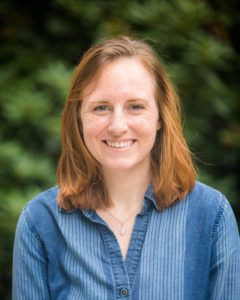 2020 Seiler Intern Ashley Tooke is a first year Dual Degree Master’s student in History and Archives Management at Simmons University, where she plans to research the history of visual print culture and it’s intersections with medicine in America. She has a Bachelor of Arts in English with a concentration in Early American Literature from University of North Texas, and worked as a bookseller for 3 years in both Boston and DC before beginning her graduate work.
2020 Seiler Intern Ashley Tooke is a first year Dual Degree Master’s student in History and Archives Management at Simmons University, where she plans to research the history of visual print culture and it’s intersections with medicine in America. She has a Bachelor of Arts in English with a concentration in Early American Literature from University of North Texas, and worked as a bookseller for 3 years in both Boston and DC before beginning her graduate work.


